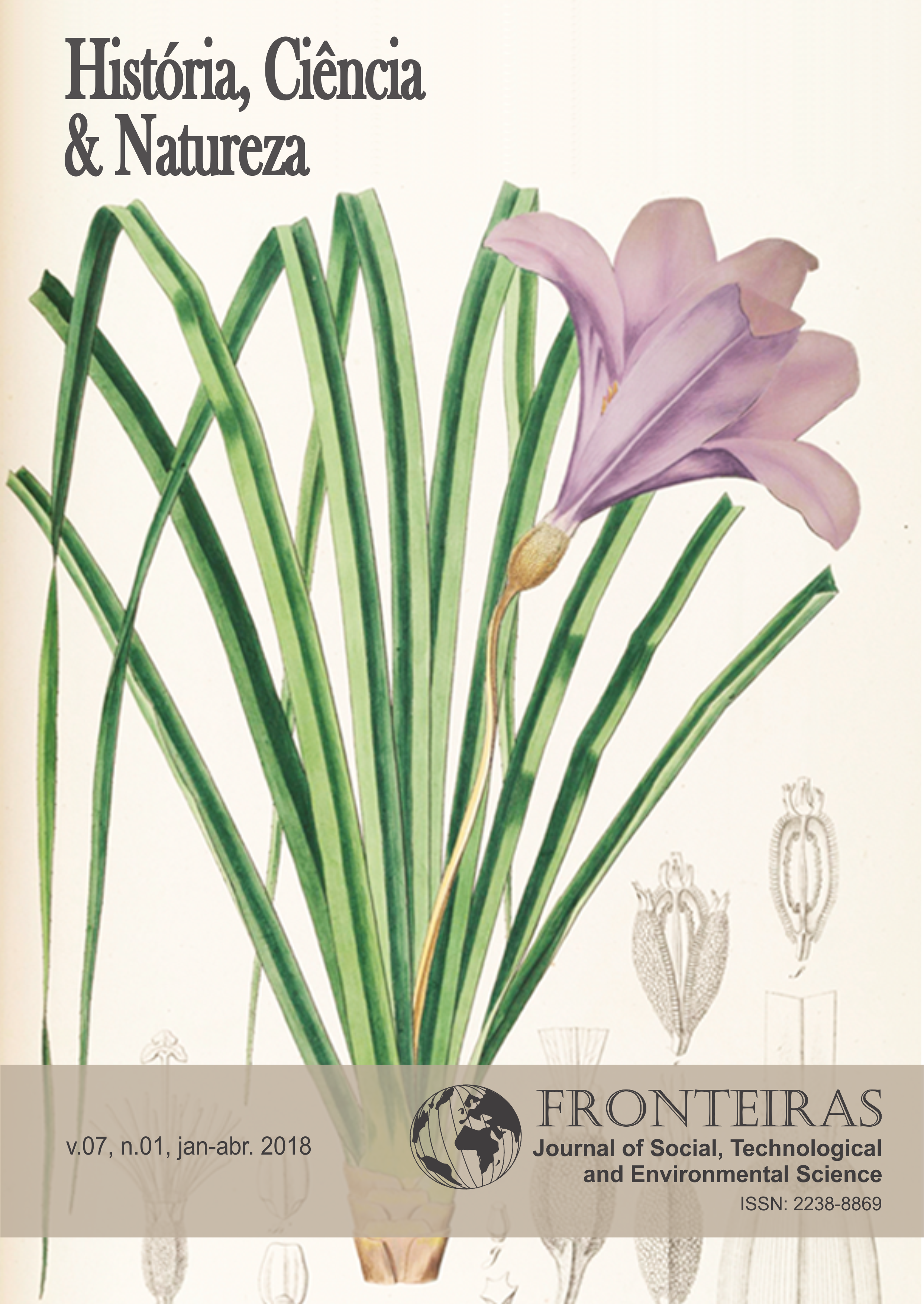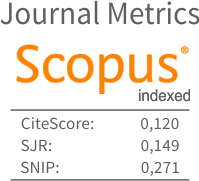Traditional Knowledge of Trees and Cultivated Plants in a Coastal Municipallity in Sao Paulo State, Brazil
A cognitive experience
DOI:
https://doi.org/10.21664/2238-8869.2018v7i1.p249-264Palavras-chave:
Listagens Livres, Etnobotânica, Ecologia Histórica, Etnobotânica Quantitativa, Vale do RibeiraResumo
Os conceitos teóricos da Ecologia histórica foram utilizados para acessar o conhecimento tradicional em uma região litorânea do estado de São Paulo, Núcleo Pedro de Toledo, no Parque Estadual da Serra do Mar. Exercícios de listagem livre que acessam domínios semânticos considerados relevantes para o conhecimento tradicional foram aplicados aos moradores locais. Quarenta e duas entrevistas foram realizadas com adultos (entre 18 e 75 anos de idade) sobre as plantas cultivadas e árvores na região. Os conhecimentos e os dados dos entrevistados foram analisados através dos Smiths 'S, um índice de frequência de dados. Os resultados mostraram que as plantas cultivadas e árvores são domínios da realidade psicológica para essa comunidade. Recursos metodológicos da antropologia cognitiva que se aplicam para a compreensão da ecologia histórica mostraram-se de alto valor como ferramenta multidisciplinar e de fácil e ampla aplicabilidade em estudos ecológicos.
Referências
Adams C 2002. Identidade Caiçara: exclusão histórica e sócio-ambiental. In UP Albuquerque, Atualidades em Etnobiologia e Etnoecologia. Palestras Convidadas do IV Simpósio Brasileiro de Etnobiologia e Etnoecologia, Recife. p. 27-43.
Alvares CA, Stape JL, Sentelhas PC, de Moraes Gonçalves JL, Sparovek G 2013. Köppen's climate classification map for Brazil. Meteorologische Zeitschrift, 22(6):711-728.
Arruda ST, Perez, LH, Bessa Jr. AA 1993. A Bananicultura no Vale do Ribeira – Caracterização dos Sistemas de Produção. Agricultura em São Paulo, 40(1):1-17.
Atran S, Medin D 2008. The Native Mind and the Cultural Construction of Nature. MIT Press, Cambridge, 333 pp.
Atran S, Medin D, Ross R, Lynch E, Vapnarsky V, Ek’ EU, Coley J, Timura C, Baran M 2002. Folk Ecology, Cultural Epidemiology, and the Spirit of the Commons. Curr Anthropol, 43(3):421-450.
Balée WL 1989. Resource Management in Amazonia: indigenous and folk strategies. In DA Posey, WL Balée, The culture of Amazonian forests. The New York Botanical Garden Press, New York. p. 1-21.
Balée WL 1999. Footprints of the Forest: Ka'apor Ethnobotany - The Historical Ecology of Plant Utilization by an Amazonian People. Columbia University Press, New York, 416 pp.
Balée WL 2006. The research program of historical ecology. Annu Rev Anthropol, 35(1): 75-98.
Balée WL 2008. Sobre a indigeneidade das paisagens. Rev Arqueol, 21(2): 9-23.
Balée WL, Badie MC 2009. The Meaning of “Tree” in Two Different Tupí-Guaraní Languages from Two Different Neotropical Forests. Amazônica, 1(1): 96-135.
Begossi A 1995. Fishing spots and sea tenure: incipient forms of local management in Atlantic Forest coastal communities. Hum Ecol, 23(3): 387-406.
Begossi A, Leitão-Filho HF, Richerson P 1993. Plant uses in a Brazilian coastal fishing community (Búzios Island). J Ethnobiol, 13(2): 233-256.
Borgatti SP 1996. ANTHROPAC 4.0 Methods Guide. Analytic Technologies, Natick, MA.
Borges AL, Silva AL, Batista DC, Moreira FRB, Fliri JE, Oliveira JEM, Araújo JLP, Pinto JM, Castro JMC, Moura MSB, Azoubel PM, Cunha TJF, Silva SO, Cordeiro ZJM 2009. Sistema de Produção da Bananeira Irrigada. Embrapa Semiárido, Sistemas de Produção, 4. Available from: https://ainfo.cnptia.embrapa.br/digital/bitstream/item/110622/1/Sistema-de-Producao-da-Bananeira-Irrigada.pdf.
Buarque de Holanda S 1994. Caminhos e Fronteiras. Companhia das Letras, São Paulo, 301 pp.
Clement CR, Junqueira AB 2010. Between a pristine myth and an impoverished future. Biotropica, 42: 534-536.
Colonese AC, Collins M, Lucquin A, Eustace M, Hancock Y, Ponzoni RAR, Mora A, Smith C, DeBlasis P, Figuti L, Wesolowski V, Plens CR, Eggers S, Farias DSE, Gledhill A, Craig OE 2014. Long-Term Resilience of Late Holocene Coastal Subsistence System in Southeastern South America. Plos One, 9(8): e107034.
Diegues AC 2003. Aspectos sociais e culturais do uso dos recursos naturais da Mata Atlântica. In LL Simões, CF Lino, Sustentável Mata Atlântica: a exploração de seus recursos florestais. 2.ed. Editora SENAC, São Paulo, p.135-158.
Diegues AC 2007. O Vale do Ribeira e litoral de São Paulo: meio-ambiente, história e população. CENPEC, São Paulo. Available from: https://www.usp.br/nupaub/cenpec.pdf.
Erickson CL 2008. Amazonia: the historical ecology of a domesticated landscape. In H Silverman, W Isbell, Handbook of South American Archaeology. Springer, New York, p. 157-183.
Erickson CL, Balée WL 2006. The Historical Ecology of a Complex Landscape in Bolivia. In WL Balée, CL Erickson, Time and Complexity in Historical Ecology. Columbia University Press, New York, p. 186-233.
Fausto C 2000. Os Índios antes do Brasil. Jorge Zahar Editora, Rio de Janeiro, 94 pp.
Gunter CA, Scott DS 1994. Semantic Domains. In J van Leeuwen, Handbook of Theoretical Computer Science v.2. MIT Press, Cambridge, p. 633-674.
Heckenberger MJ, Kuikuro A, Kuikuro UT, Russell JC, Schmidt M, Fausto C, Franchetto B 2003. Amazonia 1492: pristine forest or cultural Parkland?. Science, 301(5640):1710-1714.
Heckenberger MJ, Russell JC, Fausto C, Toney JR, Schmidt M, Pereira E, Franchetto B, Kuikuro A 2008. Pre-Columbiam Urbanism, Anthropogenic Landscapes and the Future of the Amazon. Science, 321(5893):1214-1217.
IBGE 2012. Manual técnico da vegetação brasileira. 2.ed. Série Manuais Técnicos em Geociências, IBGE, v.1, 271 pp.
Instituto Florestal 2009. Plano de Manejo PESM.
Iriarte J, Behling H 2007. The expansion of Araucaria forest in the southern Brazilian highlands during the last 4000 years and its implications for the development of the Taquara/Itararé Tradition. Env Archaeol, 12(2): 115-127.
Köppen W 1931. Grundriss der Klimakunde. W. de Gruyter, 388pp.
Köppen W, Geiger R 1936. Handbuch der klimatologie. Gebrüder Borntraeger, Berlin
Moraes GI 2007. Estratégias para a comercialização da banana no Vale do Ribeira. Cad Econ, 11(20):1-10.
Noelli FS 1999. A ocupação humana na Região Sul do Brasil: Arqueologia, debates e perspectivas 1872 – 2000. Revista USP, 44: 218-269.
Noelli FS 2008. The Tupi Expansion. In H Silverman, WH Isbell, Handbook of South American Archaeology. Springer Science+Business Media, New York. p. 659-670.
Nunes M 2003. Do passado ao futuro dos moradores tradicionais da Estação Ecológica Juréia-Itatins/SP. MSc. Thesis, Faculdade de Filosofia, Letras e Ciências Humanas, Universidade de São Paulo. 152pp.
Orr Y, Hallmark B 2014. Folk Food Webs and the Role of Praxis in Substantive Ecological Knowledge. Hum Ecol, 42: 339-346.
Peroni N, Hanazaki N 2002. Current and lost diversity of cultivated varieties, especially cassava, under swidden cultivation systems in the Brazilian Atlantic Forest. Agric Ecosyst Environ, 92(2-3): 171-183.
Pylyshyn ZW 1972. Competence and psychological reality. Am Psychol, 27(6): 546-552.
Quinlan M 2005. Considerations for Collecting Freelists in the Field: Examples from Ethobotany. Field Methods, 17: 1-16.
Romney AK, Moore CC 1998. Toward a Theory of Culture as Shared Cognitive Structures. Ethos, 26(3): 314-337
Romney AK, Weller SC, Batchelder WH 1986. Culture as Consensus: A Theory of Culture and Informant Accuracy. Am Anthropol, 88(2): 313-338.
Roosevelt AC, Costa ML, Machado CL, Michab M, Mercier N, Valladas H, Feathers J, Barnett W, Silveira MI, Henderson A 1996. Paleoindian cave dwellers in the Amazon: the peopling of the Americas. Science, 272: 373-384.
Sauer CO 1925. The Morphology of Landscape. University of California Publications in Geography, 22: 19-53.
Schann D, Pärssinen M, Ranzi A, Piccoli JC 2007. Geoglifos da Amazônia ocidental: evidência de complexidade social entre os povos da terra firme. Revista de Arqueologia, 20(20): 67-82.
Scheel-Ybert R 2000. Vegetation stability in the Southeastern Brazilian coastal area from 5500 to 1400 14C yr BP deduced from charcoal analysis. Rev Palaeobot Pal, 110(1-2): 111-138.
Scheel-Ybert R, Eggers S, Wesolowski V, Petronilho C, Boyadjian C, DeBlasis P, Barbosa-Guimarães M, Gaspar MD 2003. Novas perspectivas na reconstituição do modo de vida dos sambaquieiros: uma abordagem multidisciplinar. Revista de Arqueologia, 16: 109-137.
Smith JJ, Borgatti SP 1997. Salience counts – and so does accuracy: Correcting and updating a measure for free-list-item salience. J Ling Anthropol, 7: 208-209.
Vialou D, Benabdelhadi M, Feathers J, Fontugne M and Vialou AV 2017. Peopling South America's centre: the late Pleistocene site of Santa Elina. Antiquity, 91(358): 865-884.
Zuchiwschi E, Fantini AC, Alves AC, Peroni N 2010 Limitações ao uso de espécies florestais nativas pode contribuir com a erosão do conhecimento ecológico tradicional e local de agricultores familiares. Acta Bot Bras ,24(1): 270-282.
Downloads
Publicado
Como Citar
Edição
Seção
Licença
Esta revista oferece acesso livre imediato ao seu conteúdo, seguindo o princípio de que disponibilizar gratuitamente o conhecimento científico ao público proporciona maior democratização mundial do conhecimento.
A partir da publicação realizada na revista os autores possuem copyright e direitos de publicação de seus artigos sem restrições.
A Revista Fronteiras: Journal of Social, Technological and Environmental Science segue os preceitos legais da licença Creative Commons - Atribuição-NãoComercial 4.0 Internacional.


